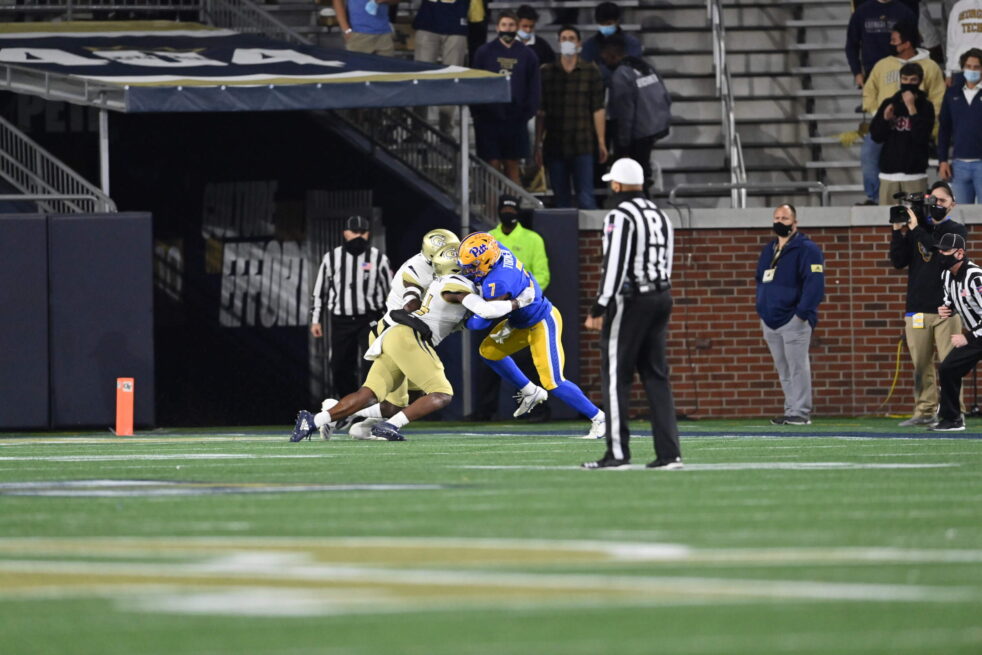It’s mid-March 2020, and everything is stopping. Students are heading home for what at first was supposed to be an extended spring break, but soon became much more. Stay-at-home orders and mask mandates rolled out, and the world changed heavily from that point onward.
As the virus spread around the world and things began to shut down, the sports world was still in full swing. Just as fast as everything else changed though, we went from having games from several different sports on any given night to practically nothing for three months. Rudy Gobert, the starting center for the Utah Jazz, gained notoriety and was at least a contributor to the rapid shutdowns. When discussing the early Covid protocols being implemented before the shutdown, Gobert seemed to be taking it lightly as he touched every microphone in front of him at a press conference. Two days later, Gobert officially tested positive for COVID-19, almost immediately followed by the NBA’s announcement that it would be suspending its season.
Utah’s March 11 game was postponed minutes before tipoff, as were the remaining games of the evening. Some teams, including the Hawks, had already begun to play that night, and had to finish their games wondering if there would be a next game. In the days following, more Jazz players tested positive, and as cases grew nationwide, the remaining leagues in play began to suspend operations.
After the NBA announced their suspension and positive tests, the rest of the sports world scrambled to follow suit. Some tried to hold out longer than others in hopes of the initial cases being an isolated incident, but before long all sports had subsided. The NHL and its affiliate leagues halted on March 12, and by the end of the day on the 13th the sports world was turned on its head.
The PLAYERS Championship only got through its March 12 first round before being called off. In college basketball, a Big East conference tournament game was called off at halftime, and the ACC tournament was canceled and Florida State was crowned champion just before the tipoff of the Seminoles’ matchup with Clemson. In the hours following, the NCAA canceled both the mens’ and womens’ tournaments outright, marking the first time the tournament had ever been called off. Atlanta sports were no different. The Hawks were mid-game when the NBA announced the shutdown, becoming one of the teams that had to play through confusion in an eventual overtime loss to the Knicks.
Vince Carter, playing what would be his last ever NBA game, hit a three-pointer in the dying seconds of the game to a massive ovation from a crowd that knew it may be his final salute. Not even two hours after NBA commissioner Adam Silver halted play, Atlanta United played a match against Club America, the first leg of their CONCACAF Champions League matchup. After the suspension of play, the second leg was not played for another nine months, finally finishing on Dec. 16. The Braves played their spring training game as scheduled on the 11th and even played another on the 12th before the MLB shut down the Spring Training part of their season.
Without live sports, many were bereft of one of their favorite pastimes. ESPN and other major sports channels were left without much new content, and many turned to events of the past, breakdowns of historic games and players and slapped together virtual content.
Accompanied by the strange sight of the living rooms of sports punditry, athletics-based entertainment took on a different hue.
Zoom became a major necessity for broadcasting. While it was odd at first to see Shaquille O’Neal’s home while he traded barbs with Charles Barkley on air, the personalities persisted and helped fill the void left by the suspension of sports. Documentaries like The Last Dance helped us recall the greatness of past performances as we waited for the return of normalcy.
Major events did not entirely cease. The NFL draft occurred on schedule less than a month and a half after the shutdown, with players and fans enjoying the live experience from their living rooms instead of on a stage. When Burrow went first overall to the Bengals, he donned his team cap and answered interview questions with his parents. It was almost normal except for the stage being commissioner Roger Goodell’s basement.
Some turned to international sports as other countries opened up. When the Korean baseball season began, a number of idle sports bettors and action-starved fans picked teams and followed the league, despite games often being played in the early hours of the morning stateside. Bundesliga was the first major soccer league to return to action as Europe began to reopen.
Rumors of resumption in the U.S. slowly became a reality as the MLS, NBA, NHL, and MLB all announced their modified schedules for the beginning or remainder of their seasons. The MLS returned first, operating in a bubble in Orlando and playing their first games almost four months after the suspension. The NBA and NHL formed similar bubbles and successfully completed their seasons, while the MLB played an abbreviated season at teams’ empty home parks until the NLCS in Arlington. After the longest period without sports in my living memory — and most others’ too — the world’s best athletes returned to our screens live.
After a four month break, and with another eight months having followed since that point, there is much to reflect on.
Leagues the world over have figured out how to better keep their athletes safer during uncertain times, and fans have learned what a world without sports looks like.
As the one-year mark since the shutdown arrives, let us hope for the country to regain its health and for a crisis like the one that began last March never happens again.
